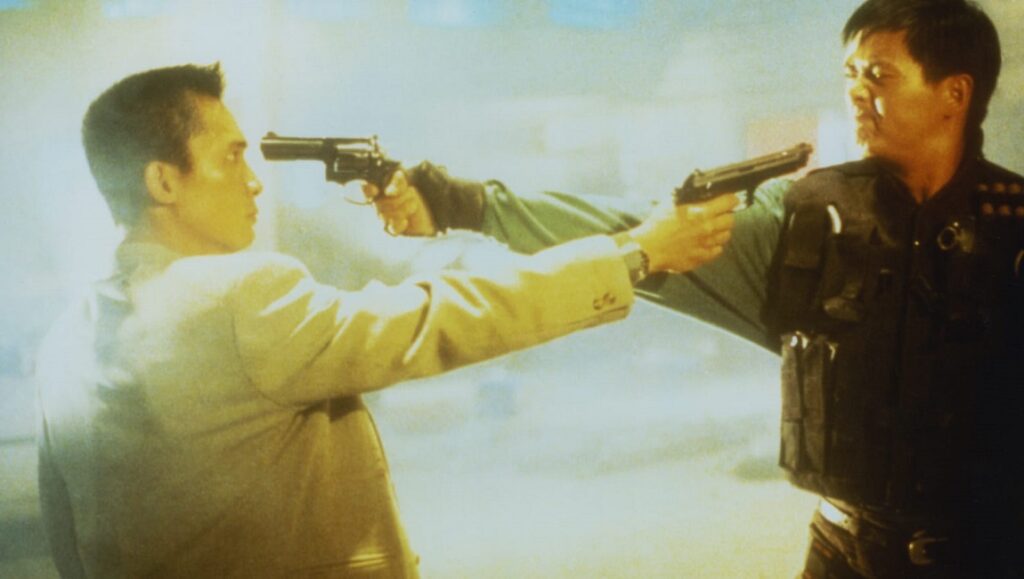For this writer, a personal cinematic pet peeve is when characters fire guns only for the bullets to seem to dissipate, never hitting anything. John Woo is, perhaps more than any other filmmaker from his generation, aware that bullets destroy shit. Every time a gun goes off, walls erupt, windows explode, bodies are ripped up and go flying — ridiculous, yes, but there’s a weight here, a sense of gravity, of consequence. This sense of consequence is why the insane action of his Hong Kong films remains poignant while most modern blockbusters feel artificial. Hard Boiled, the absolute apogee of action cinema, is riddled with bullets, shredding bodies and erupting into oddly pleasing sparks like fireworks as they slam into doors, walls, the husks of cars — splatter and sparkles.
“Give a guy a gun, he thinks he’s superman. Give him two and he thinks he’s God.” Hard Boiled is chockablock with guys with guns, and even more with gunshots. Here, the Godly Chow Yun-fat stars as an indefatigable police sergeant while a baby-faced Tony Leung Chiu-wai plays an intrepid undercover cop who has risen high in the ranks as a triad assassin. Across the film’s two hours, their paths meet and pleat until they are, in the end, inextricable, uniting to shoot it out with seemingly hundreds of bad guys with big guns, destroying a hospital but saving the day — and a bunch of babies.
Woo was one of the last masters of analog spectacle, an artist from an era before computers made the impossible boring and depleted action cinema of anything tactile. Woo’s camera is swoony and swervy, moving curvaceously, the director switching things up, shot to shot, with the most dexterous editing in cinema. Today, in a post-Wick world, the decently skilled directors working in the genre utilize the medium and employ wide shots with only rare cutting, showcasing the choreography and capping things off with CG blood. Woo cuts a lot. In his sequences, geography is logical, bullets follow their trajectory and hit what they’re aimed at, bodies fall and stay there. Take, for instance, the scene in Hard Boiled where Chow slides down a railing while dual-wielding guns and shooting enemies. Woo doesn’t film this to show off the stunt, but instead employs a staggering amount of cuts — almost 20 times in 20 seconds. Chow is smooth in this sequence while surrounded by bodies hitting the floor; sometimes slowly, sometimes quickly, always violently.
But Woo is a master of melodrama as much as he is of action. As with his lyrical and elegiac The Killer and his later heroic Hollywood efforts Broken Arrow and the flat-out awesome Face/Off, and even in his unfairly-derided Mission: Impossible II (which, while neutered, is still replete with Woo-ist touches), there’s a theme of duality, of partnership and friendship and the depths of bromance, on which the extraordinary set-pieces of Hard Boiled are founded. Chow and Leung have better chemistry than any leads in any romantic comedy of the last 20 years, with riotous raillery and a palpable sense of unity and determination to get the baddies. (It’s easy to go back and forth between The Killer, which is more soulful and tragic, and Hard Boiled, which is a triumphant, more formally daring affair. In true Woo fashion, they are an inextricable pair, two embodiments of the same passions and vision.)
Woo’s films are also always concerned with morality, but there are no cumbersome lessons; the juxtaposition between cop and criminal, good and evil, redemption and damnation is gunmetal gray. All of which is to say, there’s poetry in Woo’s violence, as when Chow plugs a baby’s ears with cotton and lights up so many men, all of their blasted bodies bursting into blood and viscera as the baby gazes with gleaming goo-goo eyes. So while Chow can deliver a stony-eyed glare as well as anyone, Woo unburdens his films of the self-severity and stoicism of modern action. Instead, he makes friendship and masculinity and morality and heroism and the ravaging of human bodies by metal projectiles oddly, alluringly beautiful.
Part of Kicking the Canon — The Film Canon.
Published as part of InRO Weekly — Volume 1, Issue 6.


Comments are closed.